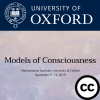Gustav Bernroider - Neural sense relations and consciousness: a diagrammatic approach
Gustav Bernroider
University of Salzburg, Dept. of Biosciences, Austria
Are there knowable criteria for subjective entities such as conscious experience? I think there are, even physical ones. I advocate the view that the basic dualism between subject and object or mind and matter can be figured by an intuitively simple version of an inside out or inversion relation between two opposing physical domains. I propose a particular topology for subject-object relations and argue that we can find a physical realisation in the brain of living organism that provides a conformal transformation between both domains. The transformation combines two physical domains related by inversion or parity symmetry or simply by mirror reflections. This view puts topological aspects behind inversion and the associated hidden symmetries in physics into the foreground.
I introduce the model along three steps: i) evidence and motivation for the role of mirror symmetries from psychobiology based on previous studies (Senso- motory invariance in animal feelings [Bernroider G, Panksepp J. (2011), Neurosci & Biobehav. Rev., 35, 2009-2016.] and mirror-writing in (my grand-) children), ii) an intuitive diagrammatic demonstrating subject-object together with cause and effect relations mapped onto an inversive plane geometry and iii) a more formal outline and extension into the algebraic topology of non- orientable surfaces, the real and complex projective plane.
The concept suggested here offers several testable predictions for the relation of ionic brain function to inversion symmetries realised by the molecular architecture of excitable membranes. For example, this aspect seems to be evidenced by enantio-selective electronic transitions during ion conduction in the brain [Bernroider G. (2017) JIN 16, 105-113]. Going beyond these technical aspects, the present view on modelling subjectivity shifts the role of canonical coordinates together with their static dimensional geometry into the background. It favours ideas behind general covariance. A parity transformation, if purely defined at the level of Cartesian coordinates with changing signs, is discrete, the transient itself only inferential, non-physical, with no known conserved quantity associated with this transformation in the sense of Emmy Noether’s theorem. However, if the same transformation is laid out continuously on the geometry of non-orientable surfaces (e.g. on a Möbius band), the transients gain some physics and offer a conserved quantity. I will discuss this conserved quantity with respect to subjectivity and consciousness.
Filmed at the Models of Consciousness conference, University of Oxford, September 2019.




